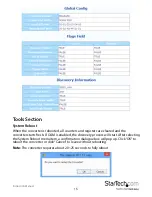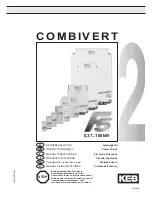
Instruction Manual
8
Management -
(Default: Enabled) If disabled, all management communication with
a remote converter will be stopped. Only normal Ethernet transmission will occur
without any possibility of remote management through 802.3ah OAM.
Jumbo Frames (9k byte packets) –
(Default: Disabled) Enable to add Jumbo Frame
support.
Note: Jumbo frames can only work on a pure Jumbo frame network where all devices
support it.
Auto Laser Shutdown (ALS) -
A safety mechanism that will disable laser output when
no received optical signal is sensed. By default, ALS is disabled.
Link Loss Carry Forward –
(Default: Disabled) A method of forwarding a link loss from
copper to fiber or from fiber to copper.
Forward CRC Frame –
(Default: Disabled) The normal behavior of a switch is to read
the entire Ethernet frame (store), calculate the check sum and compare to the FCS
in the packet. If the checksum matches, the packet is transmitted (&forward). If the
checksum does not match, the switch considers the packet to have CRC error and
drops it. If this option is enabled, the packet with CRC error will still be forwarded
instead of being dropped.
Forward Pause Frame -
(Default: Disabled) Enable to allow pause frame forwarding
to occur. Pause frames are special broadcast frames defined in IEEE802.3x, normally
used by the switch to throttle packets through a bottleneck rather than drop excess
packets (E.g. A 1Gbps stream is exiting a 100Mbps port). Normally, pause frames are
not forwarded between interfaces in the switch.
Management Packet High Priority –
(Default: Enabled) Provides Quality of Service
(QoS) functions to maintain a certain level of performance for specific applications (E.g.
Voice and Video over IP). In Ethernet, QoS is dependent on VLAN tagged packets. This is
because the QoS priority bits (3 bits) are included in the VLAN tag. Without VLAN tags,
there are no priority bits, and no way to set QoS Priority. QoS Priority is enabled by
default, but if there are no VLAN tagged packets, the enabled setting is meaningless.
Broadcast Storm Filter -
(Default: Disabled) Enable to recognize and block the
forwarding of excessive broadcast traffic. Broadcast Storm is a condition where either a
loop exists on the network or an Ethernet transceiver is bad and exhibiting jabber.
Multicast Storm Filter -
(Default: Disabled) Enable to block multicast traffic. Many
applications like video streaming, IP punch clocks, etc. come with multicast or some
broadcast-based protocol turned on by default. Multicast storms happen when
application participants request re-transmits of information they have missed.
Unknown DA Unicast Storm Filter -
(Default: Disabled) Enable to block unknown
unicast traffic flooding at a specific port.
Summary of Contents for ET91000LCOAM
Page 23: ...Instruction Manual 20 ...










































